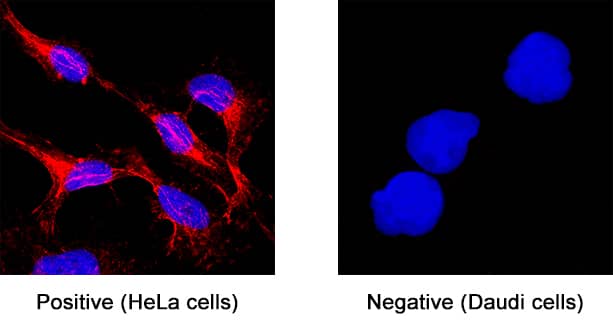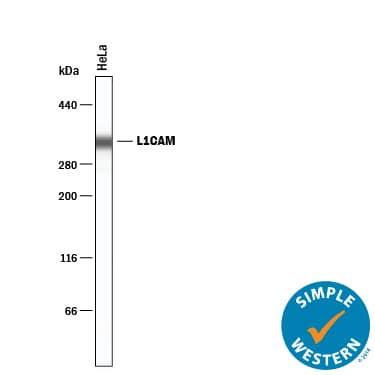Human L1CAM Antibody
R&D Systems, part of Bio-Techne | Catalog # MAB7773
Recombinant Monoclonal Antibody.


Conjugate
Catalog #
Key Product Details
Species Reactivity
Human
Applications
Flow Cytometry, Immunocytochemistry, Simple Western, Western Blot
Label
Unconjugated
Antibody Source
Recombinant Monoclonal Rabbit IgG Clone # 2702C
Product Specifications
Immunogen
Mouse myeloma cell line NS0 derived Human L1CAM
(Ile20Glu1120) & (Arg864Glu1120)
Accession # CAA42508
(Ile20Glu1120) & (Arg864Glu1120)
Accession # CAA42508
Specificity
Detects human L1CAM in direct ELISAs.
Clonality
Monoclonal
Host
Rabbit
Isotype
IgG
Scientific Data Images for Human L1CAM Antibody
Detection of Human L1CAM by Western Blot.
Western blot shows lysates of HeLa human cervical epithelial carcinoma cell line and human brain (motor cortex). PVDF membrane was probed with 2 µg/mL of Rabbit Anti-Human L1CAM Monoclonal Antibody (Catalog # MAB7773) followed by HRP-conjugated Anti-Rabbit IgG Secondary Antibody (HAF008). A specific band was detected for L1CAM at approximately 250 kDa (as indicated). This experiment was conducted under reducing conditions and using Western Blot Buffer Group 1.Detection of L1CAM in HeLa Human Cell Line by Flow Cytometry.
HeLa human cervical epithelial cell line was stained with Rabbit Anti-Human L1CAM Monoclonal Antibody (Catalog # MAB7773, filled histogram) or Rabbit IgG isotype control antibody (MAB1050, open histogram), followed by Phycoerythrin-conjugated Anti-Rabbit IgG Secondary Antibody (F0110). Staining was performed using our Staining Membrane-associated Proteins protocol.L1CAM in HeLa Human Cell Line.
L1CAM was detected in immersion fixed HeLa human cervical epithelial carcinoma cell line (positive staining) and Daudi human Burkitt's lymphoma cell line (negative staining) using Rabbit Anti-Human L1CAM Monoclonal Antibody (Catalog # MAB7773) at 3 µg/mL for 3 hours at room temperature. Cells were stained using the NorthernLights™ 557-conjugated Anti-Rabbit IgG Secondary Antibody (red; NL004) and counterstained with DAPI (blue). Specific staining was localized to cell membrane. Staining was performed using our protocol for Fluorescent ICC Staining of Non-adherent Cells.Applications for Human L1CAM Antibody
Application
Recommended Usage
Flow Cytometry
0.25 µg/106 cells
Sample: HeLa human cervical epithelial cell line
Sample: HeLa human cervical epithelial cell line
Immunocytochemistry
3-25 µg/mL
Sample: Immersion fixed HeLa human cervical epithelial carcinoma cell line and MCF‑7 human breast cancer cell line
Sample: Immersion fixed HeLa human cervical epithelial carcinoma cell line and MCF‑7 human breast cancer cell line
Simple Western
20 µg/mL
Sample: HeLa human cervical epithelial carcinoma cell line
Sample: HeLa human cervical epithelial carcinoma cell line
Western Blot
2 µg/mL
Sample: HeLa human cervical epithelial carcinoma cell line and human brain (motor cortex)
Sample: HeLa human cervical epithelial carcinoma cell line and human brain (motor cortex)
Formulation, Preparation, and Storage
Purification
Protein A or G purified from cell culture supernatant
Reconstitution
Reconstitute at 0.5 mg/mL in sterile PBS. For liquid material, refer to CoA for concentration.
Formulation
Lyophilized from a 0.2 μm filtered solution in PBS with Trehalose. *Small pack size (SP) is supplied either lyophilized or as a 0.2 µm filtered solution in PBS.
Shipping
Lyophilized product is shipped at ambient temperature. Liquid small pack size (-SP) is shipped with polar packs. Upon receipt, store immediately at the temperature recommended below.
Stability & Storage
Use a manual defrost freezer and avoid repeated freeze-thaw cycles.
- 12 months from date of receipt, -20 to -70 °C as supplied.
- 1 month, 2 to 8 °C under sterile conditions after reconstitution.
- 6 months, -20 to -70 °C under sterile conditions after reconstitution.
Background: L1CAM
References
- Maness, P.F. and M. Schachner (2007) Nat. Neurosci. 10:19.
- Wei, C.H. and S.E. Ryu (2012) Exp. Mol. Med. 44:413.
- Faspel, J. and M. Grumet (2003) Front. Biosci. 8:1210.
- Herron, L.R. et al. (2009) Biochem. J. 419:519.
- Rathjen, F.G. and M. Schachner (1984) EMBO. J. 3:1.
- Keifel, H. et al. (2011) Trends Mol. Med. 17:178.
- Dihne, M. et al. (2003) J. Neurosci. 23:6638.
- Kadmon, G. et al. (1998) Dev. Immunol. 6:205.
- Itoh, K. et al. (2000) J. Neurosci. Res. 60:579.
- Jouet, M. et al. (1995) Mol. Brain Res. 30:378.
- He, Q. et al. (2012) Neurosci. Lett. 521:57.
- Thor, G. et al. (1987) EMBO J. 6:2581.
- Sadoul, K. et al. (1988) J. Neurochem. 50:510.
- Hubbe, M. et al. (1993) Eur. J. Immunol. 23:2927.
- Hoja-Lukowicz, D. et al. (2012) Glycoconj J. Apr 29. [Epub ahead of print].
- Geismann, C. et al. (2009) Cancer Res. 69:4517.
- Tischler, V. et al. (2011) Mol. Cancer 10:127.
- Mujoo, K. et al. (1986) J. Biol. Chem. 261:10299.
- Kobayashi, M. et al. (1991) Biochim. Biophys. Acta 1090:238.
- Hlavin, M.L. and V. Lemmon (1991) Genomics 11:416.
- Castellani, V. et al. (2002) EMBO J. 21:6348.
- Zhao, X. and C-H Siu (1995) J. Biol. Chem. 270:29413.
- Oleszewski, M. et al. (1999) J. Biol. Chem. 274:24602.
- Felding-Habermann, B. et al. (1997) J. Cell Biol. 139:1567.
- Kamiguchi, H. et al. (1998) J. Neurosci. 18:5311.
- De Angelis, E. et al. (2001) J. Biol. Chem. 276:32738.
- Montgomery, A.M.P. et al. (1996) J. Cell Biol. 132:475.
- Sadoul, R. et al. (1989) J. Neurochem. 53:1471.
- Reidle, S. et al. (2009) Biochem. J. 420:391.
- Lutz, D. et al. (2012) J. Biol. Chem. 287:17161.
Long Name
Cell Adhesion Molecule L1
Alternate Names
CAML1, CD171, HSAS, HSAS1, MASA, MIC5, NCAM-L1, S10, SPG1
Gene Symbol
L1CAM
UniProt
Additional L1CAM Products
Product Documents for Human L1CAM Antibody
Product Specific Notices for Human L1CAM Antibody
For research use only
